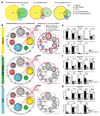c-Maf controls immune responses by regulating disease-specific gene networks and repressing IL-2 in CD4+ T cells
- PMID: 29662170
- PMCID: PMC5988041
- DOI: 10.1038/s41590-018-0083-5
c-Maf controls immune responses by regulating disease-specific gene networks and repressing IL-2 in CD4+ T cells
Erratum in
-
Publisher Correction: c-Maf controls immune responses by regulating disease-specific gene networks and repressing IL-2 in CD4+ T cells.Nat Immunol. 2019 Mar;20(3):374. doi: 10.1038/s41590-019-0331-3. Nat Immunol. 2019. PMID: 30733606
Abstract
The transcription factor c-Maf induces the anti-inflammatory cytokine IL-10 in CD4+ T cells in vitro. However, the global effects of c-Maf on diverse immune responses in vivo are unknown. Here we found that c-Maf regulated IL-10 production in CD4+ T cells in disease models involving the TH1 subset of helper T cells (malaria), TH2 cells (allergy) and TH17 cells (autoimmunity) in vivo. Although mice with c-Maf deficiency targeted to T cells showed greater pathology in TH1 and TH2 responses, TH17 cell-mediated pathology was reduced in this context, with an accompanying decrease in TH17 cells and increase in Foxp3+ regulatory T cells. Bivariate genomic footprinting elucidated the c-Maf transcription-factor network, including enhanced activity of NFAT; this led to the identification and validation of c-Maf as a negative regulator of IL-2. The decreased expression of the gene encoding the transcription factor RORγt (Rorc) that resulted from c-Maf deficiency was dependent on IL-2, which explained the in vivo observations. Thus, c-Maf is a positive and negative regulator of the expression of cytokine-encoding genes, with context-specific effects that allow each immune response to occur in a controlled yet effective manner.
Conflict of interest statement
The authors declare no competing financial interests.
Figures







Comment in
-
c-Maf in CD4+ T cells: it's all about context.Nat Immunol. 2018 May;19(5):429-431. doi: 10.1038/s41590-018-0087-1. Nat Immunol. 2018. PMID: 29670237 No abstract available.
References
Publication types
MeSH terms
Substances
Grants and funding
LinkOut - more resources
Full Text Sources
Other Literature Sources
Molecular Biology Databases
Research Materials

